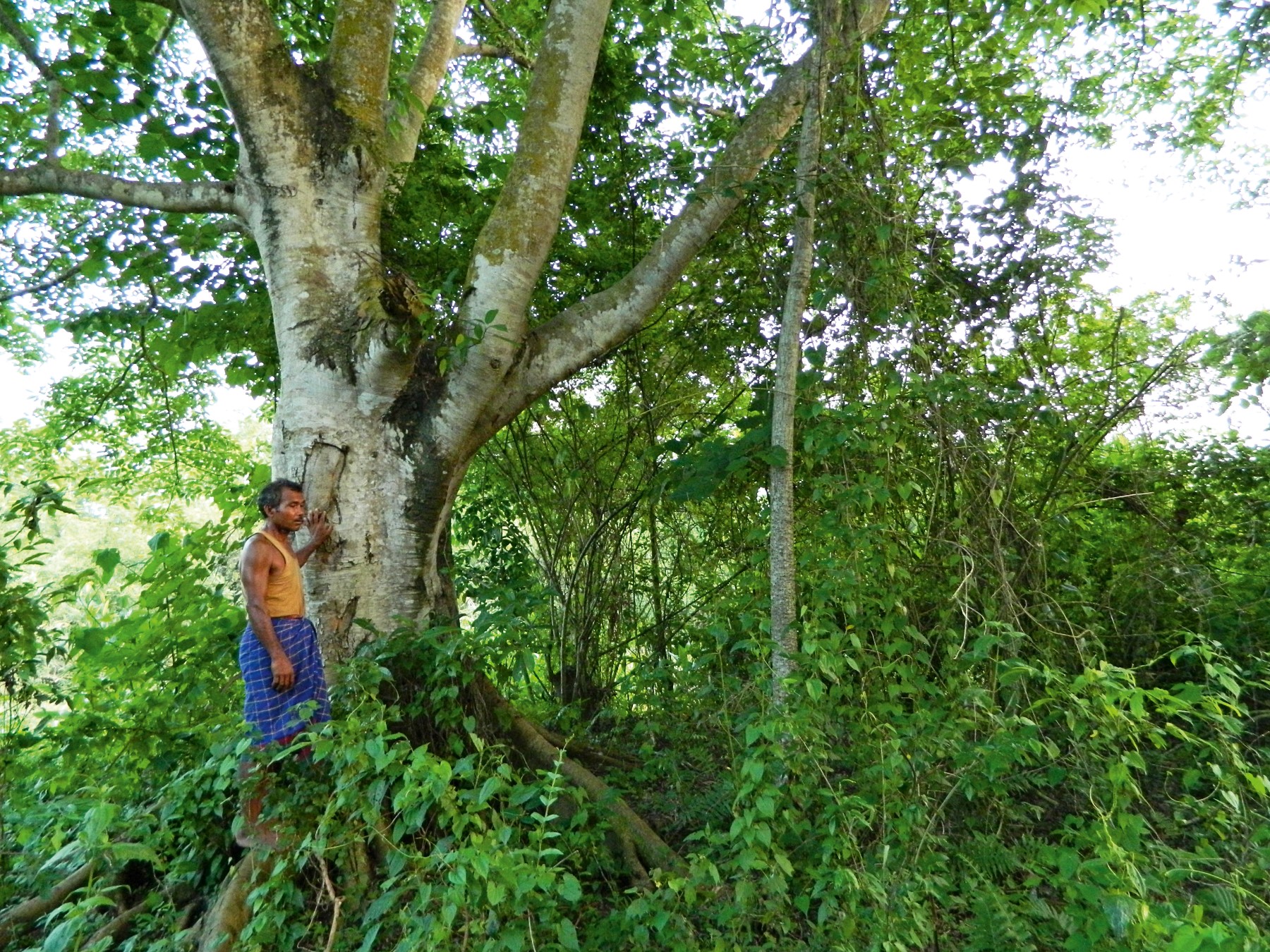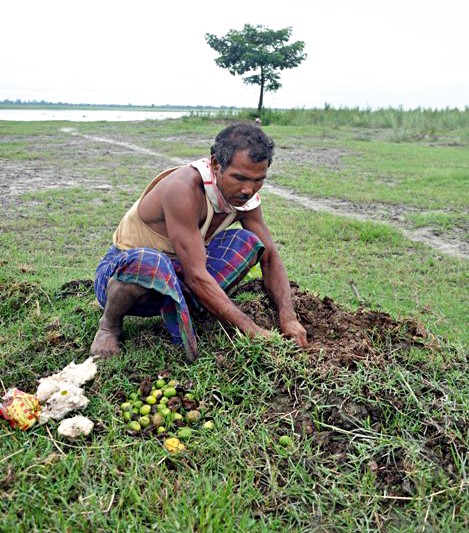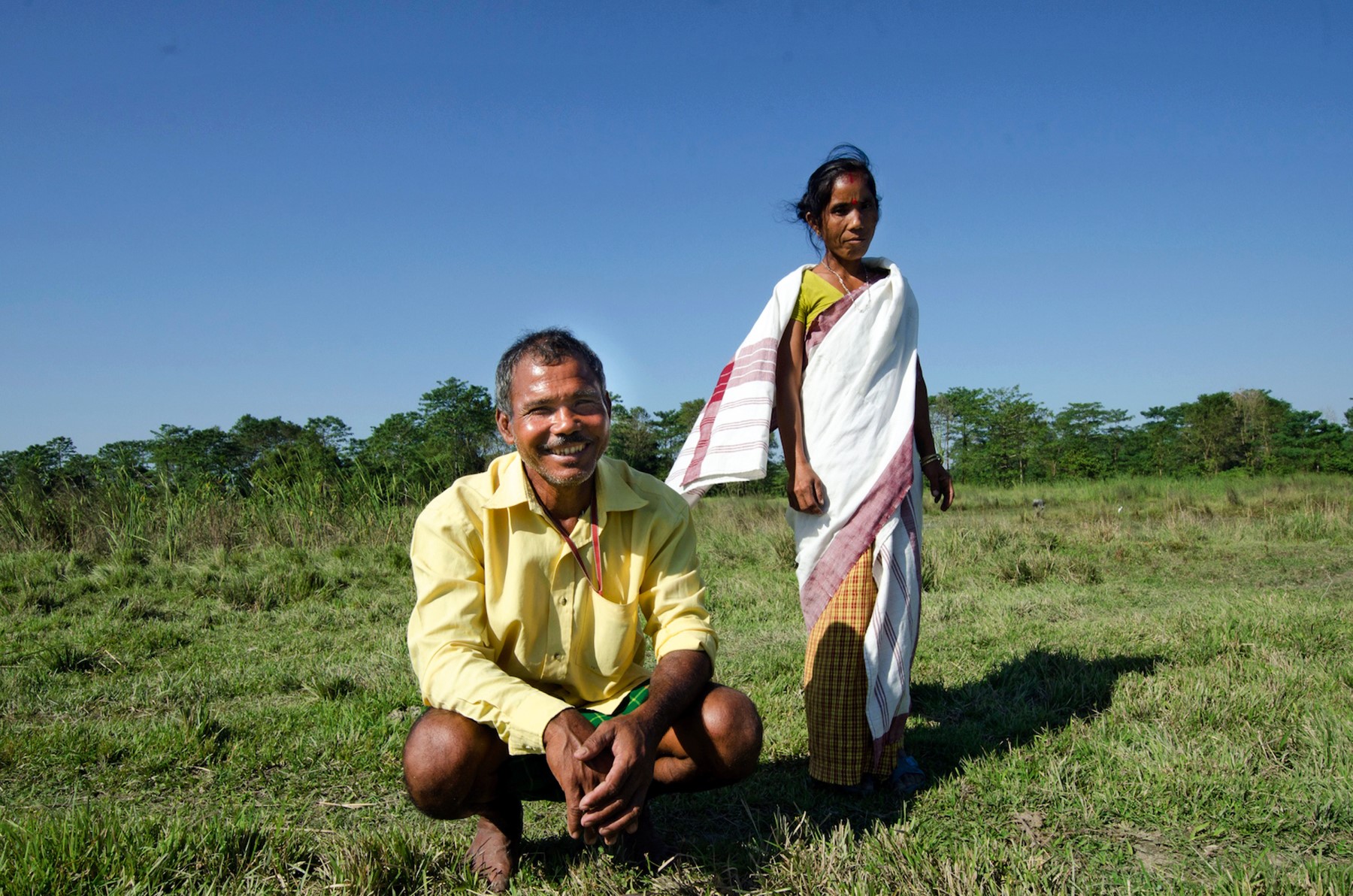The Strange Obsession of Jadav Payeng
First published in Sanctuary Asia,
Vol. 32
No. 12,
December 2012
By Shailendra Yashwant
Today, he claims, the island is covered by about 1,360 acres of dense forest. The Forest Department has not yet validated the exact size officially, but Mulai Kathoni (kathoni is forest in Assamese) as it is known locally, is already providing sanctuary to elephants migrating west from Dibrugarh, rhinos escaping the floods of Kaziranga and tigers fleeing the guns of Karbi Anglong.
Jitu Kalita, a Jorhat-based journalist who writes a popular column on nature in Prantik, an Assamese magazine, was stalking vultures when he found himself on the far side of Aruna sapori (sapori is the Assamese word for island), entering a forest, when a visibly perturbed Payeng practically attacked him and chased him off the land. A lone male wild buffalo had taken refuge in the forest and Payeng was worried that it might attack the intruder. Kalita recalls his sense of wonder as he first stepped into the forest, which was the densest in the area. Intrigued, he followed the cowherd out, only to discover the biggest story of his life.
Payeng of the Mising tribe of Northeast India, previously known as the Miris, the second largest ethnic group in Assam after the Bodos, was hired as a labourer for an afforestation project undertaken on 200 ha. of land on Aruna sapori by the Social Forestry Division of Golaghat district in 1979. The five-year project was abandoned in three years and while the rest of the workers packed up and disappeared into government files, Payeng, who had nowhere else to go, continued to plant more trees, while nurturing the existing vegetation, on his own.

Photograph by Raj Phukhan
For almost 30 years, off everyones radar, without support or subsidies, without fear or favour, without Forest Department or foreign hand, Payeng, almost obsessively, continued to expand the forest and the fruit of his labour is now being celebrated around the world. It is indeed amazing that his extraordinary mission was largely unknown until Kalita chanced upon it and made it public.
Educated upto Class 10 at a local school, Jadav Payeng, now 54 years old, is a hopeless romantic and a raving revolutionary, like so many Assamese men of the 1980s. While the rest opted for armed revolutions of many hues, Payeng chose to plant trees of many shades. The former is slowly escaping into the ether, but Payengs forest stands tall, defying the annual cycle of floods and constant erosion caused by the mighty Brahmaputra.
Payeng owns about 50 cows and buffaloes that live and graze in and around his forest. An honest man who never adulterates his produce of milk, his entire family, including his wife Binita, his sons Sanjay and Sanjiv and his daughter Moonmooni, start their day at 3.30 a.m. By eight a.m. they have milked and bathed the livestock and the milk is delivered to men who row it across to Jorhat. After a brief rest and meal, Jadav lifts his bag of seedlings and starts walking briskly through his forest to the banks of the Brahmaputra to row across to Mekahi island, his newest reforestation mission. The children go to school.
Fighting climate change
I struggle to keep up with him as he leads me with brisk strides into his forest. He splashes through streams, swamps and hot sand without altering his pace. The temperature drops a wee bit as we enter Mulai Kathoni and I am dumbstruck by how dense the forest is!
“No more global warming, if everyone plants forest," he recites. I laugh. “No, really," he says. I tell him most Americans dont believe in global warming. We didnt know then, that Hurricane Sandy was heading for the East Coast. That people would die in New York the day after, the NY stock exchange and the Presidential campaign would shut down for two days. That, for a few minutes, Americans would consider the possibility of global warming.
Payeng proudly shows me the ruins of his own home (also known as Changghar - house on stilts in the Mising style), situated on the outskirts of the forest that was destroyed when the first-ever herd of elephants arrived in 2008. He tells me how he stood and watched from a distance and realised the magnitude of what he had done. While the others watched on, baffled, he was overcome with joy. And he had every reason to be - he has succeeded in bringing life back to the island.
But his celebrations were short-lived. A few days later, angry villagers, having assessed the damage to their crops, blamed Mulai Kathoni for attracting the elephants. One mob manifested their anger by cutting down trees while another set fire to a patch at the far end. He reckons he lost one tenth of the forest in that first wave of mindless violence.
Fortunately, things have calmed down since. The ex-gratia payment for damaged crops offered by the Forest Department, the media attention and accolades bestowed on Payeng have helped in suppressing the rage of the villagers. Payeng figures the peace will last until the next elephant attack.
“Man is responsible for the well-being of all animals and birds in this world," Payeng explains. I squint. “No, really," he says. I tell him about ethnocentrism, the dictating mantra for all mankind. Its his turn to squint but he is quick to retort, “If man does not take care of all animals, who will?"

Courtesy: Dasarath Deka
On the night of August 1, when the Brahmaputra swelled for the third time this year, swallowing everything in its path, Payeng remembers hearing five gun shots. He knew at once that poachers had chased a rhino into his forest. He called Kalita to inform the Forest Department to send forest guards immediately, and Vipul Saikia, his friend, to gather a group to help save the rhino. He pleaded with people to accompany him. Heavy rain ensued and with the Brahmaputra - like a beast that could not be tamed, no one wanted to venture out. Not even the forest guards. It was too late. The carcass was found three days later with bullet holes and a missing horn.
Building the future
Payeng points out three different types of grasses, the one rhinos like, another preferred by elephants and one that is a delicacy for all ungulates. He doesnt know their English or Latin names, and asks me if I can name them. I tell him I dont eat grass, so I never really found out. He laughs heartily and says the animals dont know the names either, so it doesnt matter. A few minutes later he starts - shimloo, shishoo, bhelo, gamari, segun, jamun, aam, kathol, shirish, dimolu, kohee, koroi, arjuna, amla, kadam, krishnasure, aizar, two types of neem, bagori - pointing and naming some of the trees growing in Mulai Kathoni. Most he planted himself; others grew from the seeds dispersed by winds, birds and the Brahmaputra.
“Environmental science should be made compulsory in primary schools," says Payeng, making me miss a step, throwing ‘environmental science at me like that. It is, I tell him, but there are hardly any teachers to teach the subject. He ignores me and continues his argument. I can see that he really believes it will work - growing forests, teaching children, protecting animals - this man who had never stepped off his island until he was 24, and came running back from the fields of Nepal, the streets of Calcutta and the construction sites of Patna, where he had gone in search of a livelihood.
“Subsidy rice has made people lazy," he threw in some more of his wisdom. He was referring to the rice being doled out by the Assam Government to appease the poor and marginalised. Payengs motto was - sleep less, eat healthy, drink Apong (the favoured drink of the Misings, prepared from 101 leaves that are found in the forest), but work hard. It was clear that he and his family practiced what he preached.
We reach the hot sandy banks of the Brahmaputra, and see our destination, Mekahi, shimmer in the distance. From nowhere, Binita, Payengs wife, appears, rowing a small canoe, our transport to Mekahi. I couldnt help but admire the pair, both of them give so much of their time and energy for their work. Their home, field and the forest are a seamless factory shop floor, on which they and their children perform routine tasks with zero emissions and an efficiency that can be compared to the Japanese. There is no electricity, not even a solar lamp. They have moved their house three times already, like so many other Misings on both sides of the Brahmaputra that eats and spits out land, changing the topography and drainage of this landscape every year. Moving houses means rebuilding their homes on stilts from scratch, preparing the ground, collecting bamboos, shaping and nailing them and then tying it all together to build a three room structure that will store their minimal belongings and give them temporary safety when the river rises again.
Quietly, they pushed the boat across, first by thrusting bamboo onto the river bed and after it was too deep to continue, they switched to paddles. I tried to take a few photographs but any movement would wobble the tiny canoe dangerously, so I gave up and succumbed to the sombre mood aboard. Payeng had revealed his worst fears - the Brahmaputra totally ravaging everything in its path, the end of the Ahom civilisation, the mahapralaya (great flood) that will signal the end of the world.
Seeing the crumbling sand banks, the constant erosion, the silt in the water, the floating branches, the muddy swirl of the largest of Indias rivers, I remembered that it is still 2012, the year that was predicted by some unfortunate civilisation that went down a few centuries ago, to bring the end of the world as man knows it. I didnt think that the dam on the Brahmaputra, the controversial Lower Subhansiri Hydroelectric Project, would be the final straw, but Payeng is more or less convinced about the scenario. He nods knowingly, mulling the thought as we settle on a current that pulls us towards the other side.

Photograph by Shailendra Yashwant
Finding God
Mekahi looks like Aruna sapori forty years ago. We quickly survey the new saplings that Payeng started planting here after being honoured by the Jawaharlal Nehru University on Earth Day, April 2012, with the title of ‘Forest Man of Assam. In July, he received an award from the former President, Abdul Kalam Azad, in Mumbai. In September, he was among 900 specialists who assembled at the seventh global conference of the International Forum for Sustainable Development at Evian in France. This November he will be in Mumbai to receive yet another honour from Sanctuary Asia.
Binita reminds us to hurry up, its almost four p.m. It will soon become dark and there is a real danger of the tigress stepping out tonight to hunt. They havent seen the tiger family, a mother and three cubs, for a couple of weeks, but Binita can sense her presence today. These tigers are the reason for Payengs frustration with the Forest Department. He has repeatedly appealed for permanent Forest Department presence in the forest. The villagers support his demand, they had told me earlier that even four guards with wirelesses and guns for protection would be enough to deal with poachers and help them come together to keep the animals off their fields. The department meanwhile is waiting for the file to move. A senior officer confirmed that to me but was not sure who or what moved the file.
We get back in the canoe and row softly back to Aruna sapori as the blanket of ruby sky darkens into ebony. A small boat with logs from the hills of Arunachal Pradesh chugs past. The voice of Bhupen Hazarika from distant loudspeakers celebrating the great Assamese balladeers first death anniversary begins to grow louder. A dolphin jumps out in front of the canoe and whistles at us. Payeng laughs. “What was that?" I ask, bewildered. He whispers, “Bhagwan, Krishna, Vishwakarma, Allah, Christ, God."
Shailendra Yashwant is a documentary photographer and environmental journalist based in India. He works as a Senior Advisor on advocacy and communications at the Climate Action Network South Asia.




